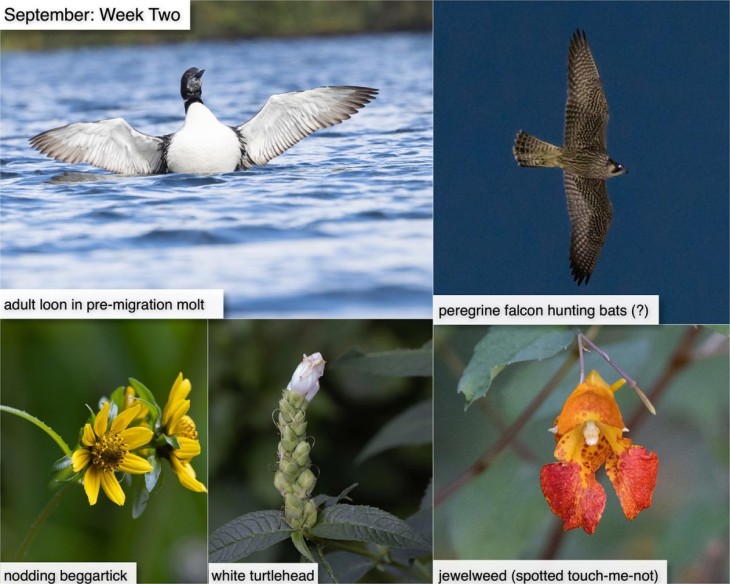This week in the woods, adult loons have begun their pre-migration partial molt. If you look closely at this adult bird, photographed from a respectful zoom lens distance in Strafford, Vermont, you’ll see that it’s developing white-to-gray patches around its beak and under the chin. Over the course of September, the plumage of adult loons becomes lighter and duller and is easy to mistake for juvenile plumage. As for a full molt, including shedding and regrowing flight feathers, that will have to wait until the birds have migrated to their winter habitat – typically, the fish-rich coastal waters of the Atlantic Ocean.
Also sighted this week, during a trip to the Ompompanoosuc River to watch bats hunting insect swarms, this night-flying peregrine falcon. Peregrines hunt bats, and although photographer Tig Tillinghast didn’t see any captures, the bird’s presence in the dark, swooping low above a river where multiple bats were flittering around, seemed pretty darned suspicious.
With the nights getting chilly, we’re starting to lose some of our late season wildflowers, but you can still see plenty of color in the woods and meadows. Jewelweed (also called spotted touch-me-not) is blooming in abundance this month. Beloved of hummingbirds (which have started migration) and other long-tongued pollinators, this tough, bright orange annual isn’t very fussy about where it grows, although it likes damp feet, and we most often find big patches of it growing in the damp soil along wetlands. The “touch-me-not” in this flower’s name refers to how it distributes seeds: pressurized seed capsules basically explode when you touch them (or a bird bites into them), launching the seeds into the air. Other wetland flowers that we’ve seen this week include white turtleheads – which are often pollinated by bumblebees, because smaller insects lack the strength to muscle their way into the blossoms’ pressed-together petals – and the pretty but unfortunately named nodding beggartick – a member of the sprawling American-aster clan.
What have you noticed in the woods this week? Submit a recent photo for possible inclusion in our monthly online Reader Photo Gallery.


